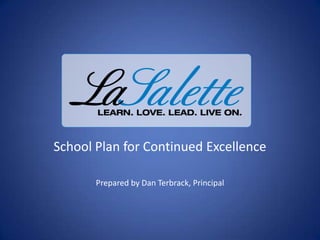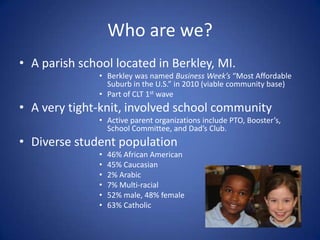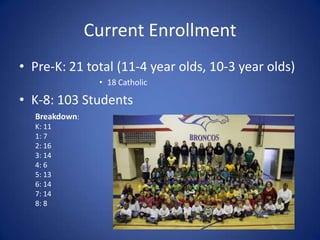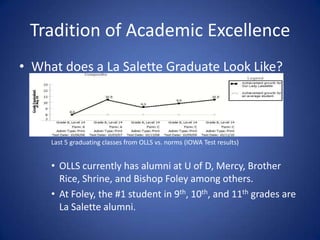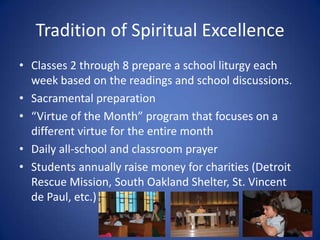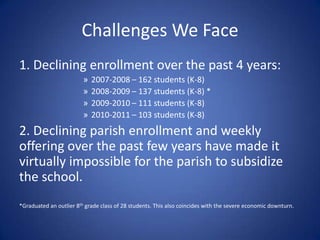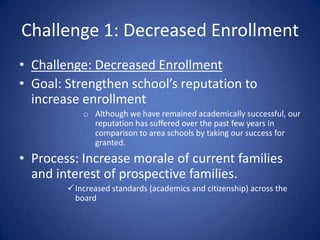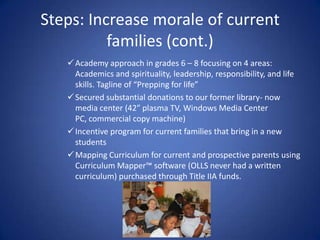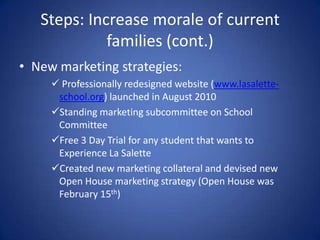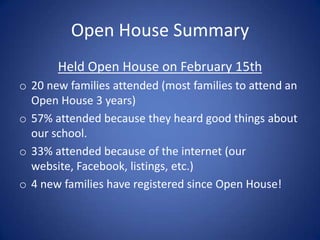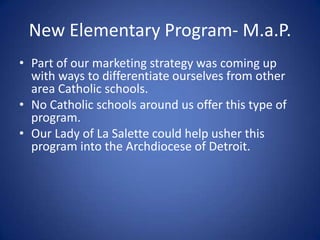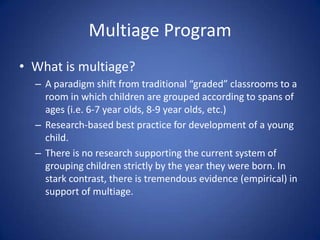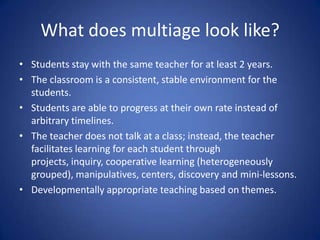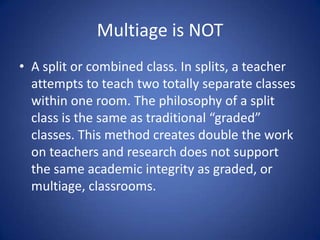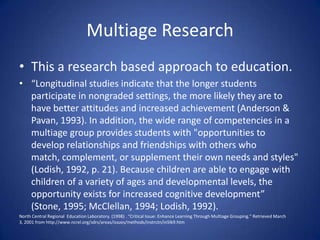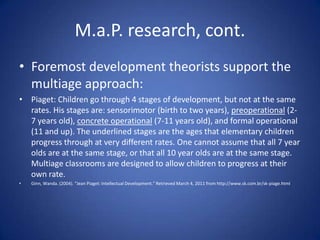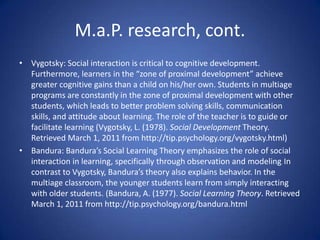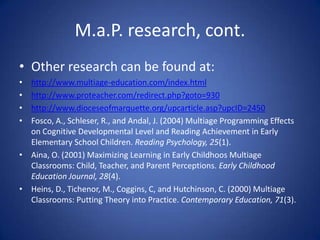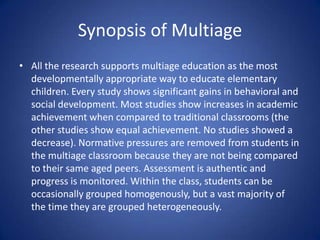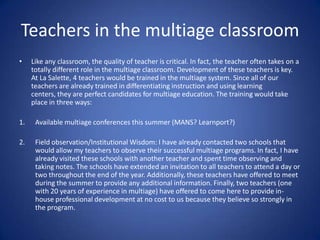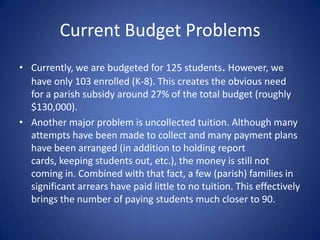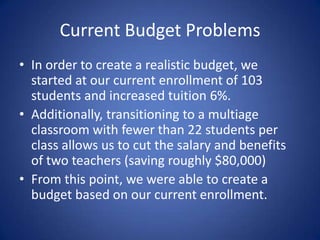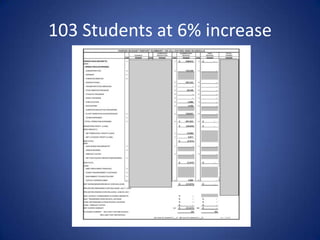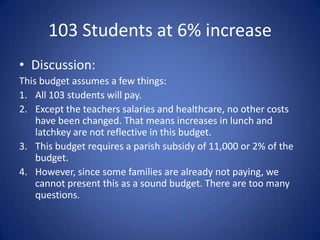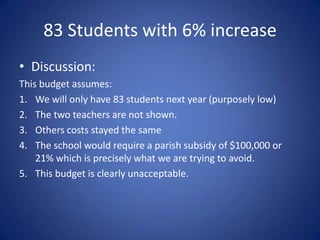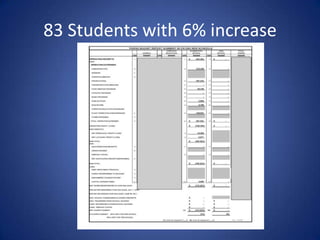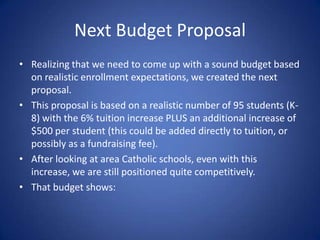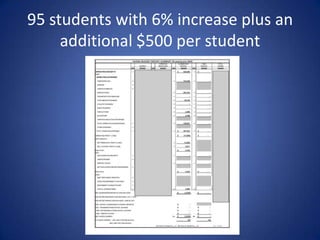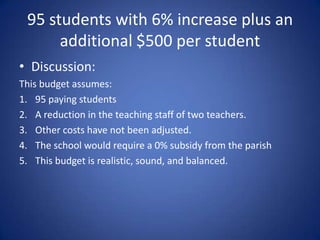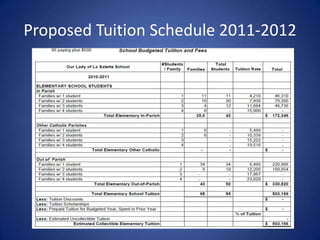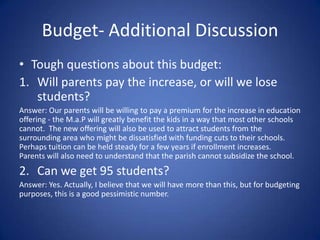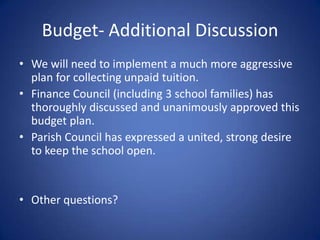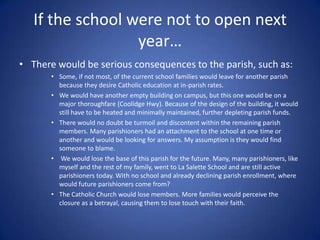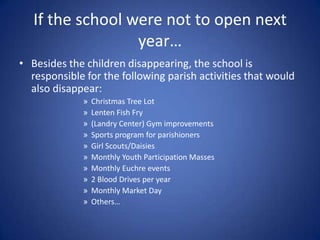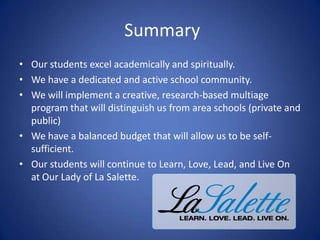School Plan 11-12
- 1. School Plan for Continued ExcellencePrepared by Dan Terbrack, Principal
- 2. Who are we?A parish school located in Berkley, MI.Berkley was named Business Week’s “Most Affordable Suburb in the U.S.” in 2010 (viable community base)Part of CLT 1st waveA very tight-knit, involved school communityActive parent organizations include PTO, Booster’s, School Committee, and Dad’s Club.Diverse student population46% African American45% Caucasian2% Arabic7% Multi-racial52% male, 48% female63% Catholic
- 3. Current EnrollmentPre-K: 21 total (11-4 year olds, 10-3 year olds)18 CatholicK-8: 103 StudentsBreakdown:K: 111: 72: 163: 144: 65: 136: 147: 148: 8
- 4. Tradition of Academic ExcellenceWhat does a La Salette Graduate Look Like?Last 5 graduating classes from OLLS vs. norms (IOWA Test results)OLLS currently has alumni at U of D, Mercy, Brother Rice, Shrine, and Bishop Foley among others.At Foley, the #1 student in 9th, 10th, and 11th grades are La Salette alumni.
- 5. Tradition of Spiritual ExcellenceClasses 2 through 8 prepare a school liturgy each week based on the readings and school discussions.Sacramental preparation“Virtue of the Month” program that focuses on a different virtue for the entire monthDaily all-school and classroom prayerStudents annually raise money for charities (Detroit Rescue Mission, South Oakland Shelter, St. Vincent de Paul, etc.)
- 6. Challenges We Face1. Declining enrollment over the past 4 years:2007-2008 – 162 students (K-8)2008-2009 – 137 students (K-8) *2009-2010 – 111 students (K-8)2010-2011 – 103 students (K-8)2. Declining parish enrollment and weekly offering over the past few years have made it virtually impossible for the parish to subsidize the school.*Graduated an outlier 8th grade class of 28 students. This also coincides with the severe economic downturn.
- 7. Challenge 1: Decreased EnrollmentChallenge: Decreased EnrollmentGoal: Strengthen school’s reputation to increase enrollmentAlthough we have remained academically successful, our reputation has suffered over the past few years in comparison to area schools by taking our success for granted.Process: Increase morale of current families and interest of prospective families.Increased standards (academics and citizenship) across the boardSteps: Increase morale of current families (cont.)Academy approach in grades 6 – 8 focusing on 4 areas: Academics and spirituality, leadership, responsibility, and life skills. Tagline of “Prepping for life”
- 8. Secured substantial donations to our former library- now media center (42” plasma TV, Windows Media Center PC, commercial copy machine)
- 9. Incentive program for current families that bring in a new students
- 10. Mapping Curriculum for current and prospective parents using Curriculum Mapper™ software (OLLS never had a written curriculum) purchased through Title IIA funds.Steps: Increase morale of current families (cont.)New marketing strategies: Professionally redesigned website (www.lasalette-school.org) launched in August 2010
- 11. Standing marketing subcommittee on School Committee
- 12. Free 3 Day Trial for any student that wants to Experience La Salette
- 13. Created new marketing collateral and devised new Open House marketing strategy (Open House was February 15th)Open House SummaryHeld Open House on February 15th20 new families attended (most families to attend an Open House 3 years)
- 14. 57% attended because they heard good things about our school.
- 15. 33% attended because of the internet (our website, Facebook, listings, etc.)
- 16. 4 new families have registered since Open House!New Elementary Program- M.a.P.Part of our marketing strategy was coming up with ways to differentiate ourselves from other area Catholic schools.No Catholic schools around us offer this type of program.Our Lady of La Salette could help usher this program into the Archdiocese of Detroit.
- 17. Multiage ProgramWhat is multiage?A paradigm shift from traditional “graded” classrooms to a room in which children are grouped according to spans of ages (i.e. 6-7 year olds, 8-9 year olds, etc.)Research-based best practice for development of a young child.There is no research supporting the current system of grouping children strictly by the year they were born. In stark contrast, there is tremendous evidence (empirical) in support of multiage.
- 18. What does multiage look like?Students stay with the same teacher for at least 2 years.The classroom is a consistent, stable environment for the students.Students are able to progress at their own rate instead of arbitrary timelines.The teacher does not talk at a class; instead, the teacher facilitates learning for each student through projects, inquiry, cooperative learning (heterogeneously grouped), manipulatives, centers, discovery and mini-lessons.Developmentally appropriate teaching based on themes.
- 19. Multiage is NOTA split or combined class. In splits, a teacher attempts to teach two totally separate classes within one room. The philosophy of a split class is the same as traditional “graded” classes. This method creates double the work on teachers and research does not support the same academic integrity as graded, or multiage, classrooms.
- 20. Multiage ResearchThis a research based approach to education.“Longitudinal studies indicate that the longer students participate in nongraded settings, the more likely they are to have better attitudes and increased achievement (Anderson & Pavan, 1993). In addition, the wide range of competencies in a multiage group provides students with "opportunities to develop relationships and friendships with others who match, complement, or supplement their own needs and styles" (Lodish, 1992, p. 21). Because children are able to engage with children of a variety of ages and developmental levels, the opportunity exists for increased cognitive development” (Stone, 1995; McClellan, 1994; Lodish, 1992).North Central Regional Education Laboratory. (1998) . “Critical Issue: Enhance Learning Through Multiage Grouping.” Retrieved March 3, 2001 from http://www.ncrel.org/sdrs/areas/issues/methods/instrctn/in5lk9.htm
- 21. M.a.P. research, cont.Foremost development theorists support the multiage approach:Piaget: Children go through 4 stages of development, but not at the same rates. His stages are: sensorimotor (birth to two years), preoperational (2-7 years old), concrete operational (7-11 years old), and formal operational (11 and up). The underlined stages are the ages that elementary children progress through at very different rates. One cannot assume that all 7 year olds are at the same stage, or that all 10 year olds are at the same stage. Multiage classrooms are designed to allow children to progress at their own rate.Ginn, Wanda. (2004). “Jean Piaget: Intellectual Development.” Retrieved March 4, 2011 from http://www.sk.com.br/sk-piage.html
- 22. M.a.P. research, cont.Vygotsky: Social interaction is critical to cognitive development. Furthermore, learners in the “zone of proximal development” achieve greater cognitive gains than a child on his/her own. Students in multiage programs are constantly in the zone of proximal development with other students, which leads to better problem solving skills, communication skills, and attitude about learning. The role of the teacher is to guide or facilitate learning (Vygotsky, L. (1978). Social Development Theory. Retrieved March 1, 2011 from http://tip.psychology.org/vygotsky.html)Bandura: Bandura’s Social Learning Theory emphasizes the role of social interaction in learning, specifically through observation and modeling. In contrast to Vygotsky, Bandura’s theory also explains behavior. In the multiage classroom, the younger students learn from simply interacting with older students. (Bandura, A. (1977). Social Learning Theory. Retrieved March 1, 2011 from http://tip.psychology.org/bandura.html
- 23. M.a.P. research, cont.Other research can be found at:http://www.multiage-education.com/index.htmlhttp://www.proteacher.com/redirect.php?goto=930http://www.dioceseofmarquette.org/upcarticle.asp?upcID=2450Fosco, A., Schleser, R., and Andal, J. (2004) Multiage Programming Effects on Cognitive Developmental Level and Reading Achievement in Early Elementary School Children. Reading Psychology, 25(1).Aina, O. (2001) Maximizing Learning in Early Childhoos Multiage Classrooms: Child, Teacher, and Parent Perceptions. Early Childhood Education Journal, 28(4).Heins, D., Tichenor, M., Coggins, C, and Hutchinson, C. (2000) Multiage Classrooms: Putting Theory into Practice. Contemporary Education, 71(3).
- 24. Synopsis of MultiageAll the research supports multiage education as the most developmentally appropriate way to educate elementary children. Every study shows significant gains in behavioral and social development. Most studies show increases in academic achievement when compared to traditional classrooms (the other studies show equal achievement. No studies showed a decrease). Normative pressures are removed from students in the multiage classroom because they are not being compared to their same aged peers. Assessment is authentic and progress is monitored. Within the class, students can be occasionally grouped homogenously, but a vast majority of the time they are grouped heterogeneously.
- 25. Teachers in the multiage classroomLike any classroom, the quality of teacher is critical. In fact, the teacher often takes on a totally different role in the multiage classroom. Development of these teachers is key. At La Salette, 4 teachers would be trained in the multiage system. Since all of our teachers are already trained in differentiating instruction and using learning centers, they are perfect candidates for multiage education. The training would take place in three ways:Available multiage conferences this summer (MANS? Learnport?)Field observation/Institutional Wisdom: I have already contacted two schools that would allow my teachers to observe their successful multiage programs. In fact, I have already visited these schools with another teacher and spent time observing and taking notes. The schools have extended an invitation to all teachers to attend a day or two throughout the end of the year. Additionally, these teachers have offered to meet during the summer to provide any additional information. Finally, two teachers (one with 20 years of experience in multiage) have offered to come here to provide in-house professional development at no cost to us because they believe so strongly in the program.
- 26. Teachers in the multiage classroomThe teachers will be provided books on multiage education (to read over the summer in preparation for the upcoming year.)Teachers will have individualized multiage development plans that chart the amount of development they receive through the aforementioned avenues. Each teacher will need a minimum of 15 multiage development hours prior to school beginning in August 2011.
- 27. Challenge 2: The Budget(I purposely started with the educational aspect because the students are the reason the school is here. Everything else, in my opinion, is secondary)Challenge: The parish cannot afford any amount of subsidy.Goal: The school will act as enterprise fund- meaning it is 100% self-sufficient. Process: Through analysis of the numbers, create a budget that allows the school to function.
- 28. Current Budget ProblemsCurrently, we are budgeted for 125 students. However, we have only 103 enrolled (K-8). This creates the obvious need for a parish subsidy around 27% of the total budget (roughly $130,000).Another major problem is uncollected tuition. Although many attempts have been made to collect and many payment plans have been arranged (in addition to holding report cards, keeping students out, etc.), the money is still not coming in. Combined with that fact, a few (parish) families in significant arrears have paid little to no tuition. This effectively brings the number of paying students much closer to 90.
- 29. Current Budget ProblemsIn order to create a realistic budget, we started at our current enrollment of 103 students and increased tuition 6%.Additionally, transitioning to a multiage classroom with fewer than 22 students per class allows us to cut the salary and benefits of two teachers (saving roughly $80,000)From this point, we were able to create a budget based on our current enrollment.
- 30. 103 Students at 6% increase
- 31. 103 Students at 6% increaseDiscussion:This budget assumes a few things:All 103 students will pay.Except the teachers salaries and healthcare, no other costs have been changed. That means increases in lunch and latchkey are not reflective in this budget.This budget requires a parish subsidy of 11,000 or 2% of the budget.However, since some families are already not paying, we cannot present this as a sound budget. There are too many questions.
- 32. Next Budget ProposalTaking into account the number of students currently not paying, we decided to change our numbers to reflect a realistic number of students. To give us some perspective, we dropped the number down to 83 students and calculated with the same 6% increase.
- 33. 83 Students with 6% increaseDiscussion:This budget assumes:We will only have 83 students next year (purposely low)The two teachers are not shown.Others costs stayed the sameThe school would require a parish subsidy of $100,000 or 21% which is precisely what we are trying to avoid.This budget is clearly unacceptable.
- 34. 83 Students with 6% increase
- 35. Next Budget ProposalRealizing that we need to come up with a sound budget based on realistic enrollment expectations, we created the next proposal.This proposal is based on a realistic number of 95 students (K-8) with the 6% tuition increase PLUS an additional increase of $500 per student (this could be added directly to tuition, or possibly as a fundraising fee).After looking at area Catholic schools, even with this increase, we are still positioned quite competitively.That budget shows:
- 36. 95 students with 6% increase plus an additional $500 per student
- 37. 95 students with 6% increase plus an additional $500 per studentDiscussion:This budget assumes:95 paying studentsA reduction in the teaching staff of two teachers.Other costs have not been adjusted.The school would require a 0% subsidy from the parishThis budget is realistic, sound, and balanced.
- 38. Proposed Tuition Schedule 2011-2012
- 39. Budget- Additional DiscussionTough questions about this budget: Will parents pay the increase, or will we lose students?Answer: Our parents will be willing to pay a premium for the increase in education offering - the M.a.P will greatly benefit the kids in a way that most other schools cannot. The new offering will also be used to attract students from the surrounding area who might be dissatisfied with funding cuts to their schools. Perhaps tuition can be held steady for a few years if enrollment increases. Parents will also need to understand that the parish cannot subsidize the school.Can we get 95 students?Answer: Yes. Actually, I believe that we will have more than this, but for budgeting purposes, this is a good pessimistic number.
- 40. Budget- Additional DiscussionWe will need to implement a much more aggressive plan for collecting unpaid tuition.Finance Council (including 3 school families) has thoroughly discussed and unanimously approved this budget plan.Parish Council has expressed a united, strong desire to keep the school open.Other questions?
- 41. If the school were not to open next year…There would be serious consequences to the parish, such as:Some, if not most, of the current school families would leave for another parish because they desire Catholic education at in-parish rates.We would have another empty building on campus, but this one would be on a major thoroughfare (Coolidge Hwy). Because of the design of the building, it would still have to be heated and minimally maintained, further depleting parish funds.There would no doubt be turmoil and discontent within the remaining parish members. Many parishioners had an attachment to the school at one time or another and would be looking for answers. My assumption is they would find someone to blame. We would lose the base of this parish for the future. Many, many parishioners, like myself and the rest of my family, went to La Salette School and are still active parishioners today. With no school and already declining parish enrollment, where would future parishioners come from?The Catholic Church would lose members. More families would perceive the closure as a betrayal, causing them to lose touch with their faith.
- 42. If the school were not to open next year…Besides the children disappearing, the school is responsible for the following parish activities that would also disappear:Christmas Tree LotLenten Fish Fry(Landry Center) Gym improvementsSports program for parishionersGirl Scouts/DaisiesMonthly Youth Participation MassesMonthly Euchre events2 Blood Drives per yearMonthly Market DayOthers…
- 43. SummaryOur students excel academically and spiritually.We have a dedicated and active school community.We will implement a creative, research-based multiage program that will distinguish us from area schools (private and public)We have a balanced budget that will allow us to be self-sufficient.Our students will continue to Learn, Love, Lead, and Live On at Our Lady of La Salette.
